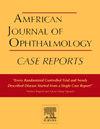Bilateral tractional retinal detachments complicating hemolytic-uremic syndrome
Q3 Medicine
引用次数: 0
Abstract
Purpose
To present a case of bilateral retinal thrombotic microangiopathy and tractional retinal detachments in a pediatric patient with typical hemolytic uremic syndrome (HUS) weeks after resolution of systemic complications.
Observations
A 23-month-old female with a history of typical HUS requiring treatment with temporary peritoneal dialysis and eculizumab transfusions presents three months later with bilateral fovea involving tractional retinal detachments. Sequential surgical repair of both eyes with pars plana vitrectomy was only successful in reattaching the superior retina of the right eye despite careful bimanual dissection. Her vision remained bare light perception in both eyes. Given similarities to advanced familial exudative vitreoretinopathy (FEVR), the trio was examined further. Genetic testing did not identify a definitive cause. Clinically, her mother had zone 3 angiographic microvascular alterations and capillary dropout consistent with stage 1 FEVR.
Conclusions and importance
We report an unusual case of a pediatric patient with typical HUS who developed bilateral blindness from tractional retinal detachments despite treatment with eculizumab and complete resolution of systemic disease. FEVR may have contributed to the severity of her retinal disease in the setting of existing thrombotic microangiopathy secondary to HUS.
双侧牵拉性视网膜脱离合并溶血性尿毒症综合征
目的报告一例典型溶血性尿毒症(HUS)患儿在全身并发症解决后数周出现双侧视网膜血栓性微血管病变和牵引性视网膜脱离。观察:一名23个月大的女性,有典型的溶血性尿毒症病史,需要临时腹膜透析和eculizumab输注治疗,3个月后出现双侧中央凹伴牵引性视网膜脱离。双眼序贯手术修复伴睫状体部玻璃体切除术仅成功地重新连接右眼上视网膜,尽管进行了仔细的双手剥离。她两只眼睛的视力仍然很弱。考虑到与晚期家族性渗出性玻璃体视网膜病变(FEVR)的相似之处,对这三人进行了进一步的检查。基因检测没有确定确切的原因。临床上,她的母亲有3区血管造影微血管改变和毛细血管脱落,符合1期发热出血热。结论和重要性:我们报告了一例典型溶血性尿毒综合征的儿童患者,尽管接受了eculizumab治疗并完全解决了全身性疾病,但仍因牵引性视网膜脱离而发展为双侧失明。出血热可能在继发于溶血性尿毒综合征的血栓性微血管病变的背景下加重了她的视网膜疾病。
本文章由计算机程序翻译,如有差异,请以英文原文为准。
求助全文
约1分钟内获得全文
求助全文
来源期刊

American Journal of Ophthalmology Case Reports
Medicine-Ophthalmology
CiteScore
2.40
自引率
0.00%
发文量
513
审稿时长
16 weeks
期刊介绍:
The American Journal of Ophthalmology Case Reports is a peer-reviewed, scientific publication that welcomes the submission of original, previously unpublished case report manuscripts directed to ophthalmologists and visual science specialists. The cases shall be challenging and stimulating but shall also be presented in an educational format to engage the readers as if they are working alongside with the caring clinician scientists to manage the patients. Submissions shall be clear, concise, and well-documented reports. Brief reports and case series submissions on specific themes are also very welcome.
 求助内容:
求助内容: 应助结果提醒方式:
应助结果提醒方式:


